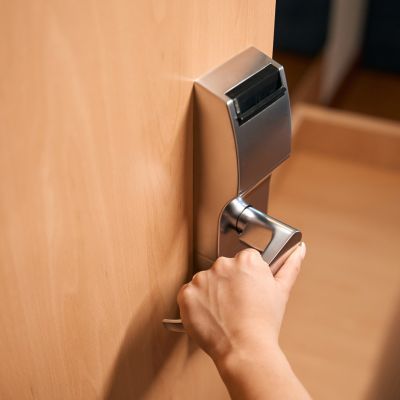Did you know the French press is one of the most popular coffee-making methods worldwide? In recent years, it’s seen a big comeback in specialty coffee shops and among home baristas. People love it because it’s simple to use and makes delicious coffee.
Learning how to use a French press is easy, and it can help you make a perfect cup of coffee right at home. Whether you are a coffee expert or just starting, using a French press is a fun and rewarding way to enjoy your favorite drink.
Let’s explore the world of the French press and learn how to brew the best coffee with it!
What is a French Press?
A French press, also known as a press pot or plunger pot, is a simple coffee-making device cherished by coffee lovers worldwide. Invented in the 1920s, it has become a staple in many households and cafes.
The French press consists of a cylindrical glass or metal container with a plunger and a built-in filter screen that presses hot water through ground coffee.
As the name suggests, the French press’s origins can be traced back to France, but it also gained popularity in Italy. Over the years, its design has remained unchanged, a testament to its effectiveness.
The French press is loved for its ability to produce rich and full-bodied coffee that highlights the beans’ natural flavors.
This brewing method is often praised for its simplicity and the control it gives users over the brewing process. It is an essential tool for anyone looking to enjoy a perfect cup of French press coffee at home.
Components of a French Press
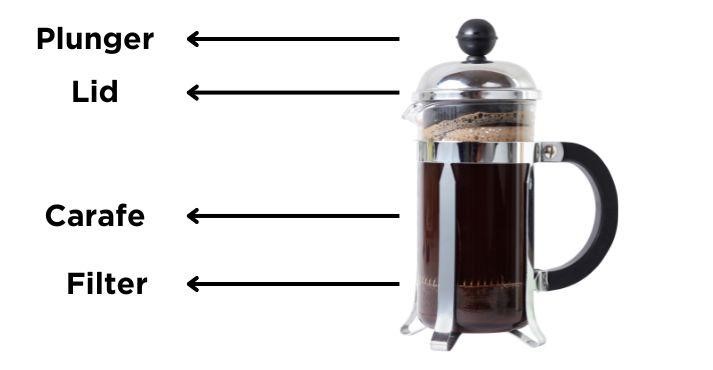
A French press consists of four main parts that work together to brew delicious coffee:
- Carafe: The cylindrical container that holds the coffee and water. It is usually made of glass, stainless steel, or plastic and designed to withstand high temperatures and keep the coffee hot.
- Plunger: A rod that fits into the carafe and presses the coffee grounds to the bottom. The plunger is typically made of stainless steel and has a handle at the top for easy pressing.
- Filter: Attached to the bottom of the plunger, the filter is a mesh screen that separates the coffee grounds from the liquid. The filter ensures that the brewed coffee is smooth and free of ground.
- Lid: The lid fits on top of the carafe and has a hole for the plunger to pass through. It helps keep the coffee hot and prevents spills while pressing.
Each component is crucial in brewing, making the French press an efficient and effective coffee maker. Here is a visual representation of these parts:
By understanding the function of each part, you can better appreciate the simplicity and effectiveness of the French press method in making French-press coffee.
How to Choose the Right French Press
Choosing the right French press is essential to ensure you get the best brewing experience and the most delicious French press coffee. Several factors should be considered, such as material and build quality, size and capacity, and filter type. Here’s a guide to help you make an informed decision.
Material and Build Quality
The material of your French press affects your coffee’s durability and flavor. Here are the common materials and their pros and cons:
- Glass: Glass French presses are popular because they allow you to see the brewing process. They are usually made from borosilicate glass, which is heat-resistant and durable. However, glass is prone to breaking if not handled carefully.
- Stainless Steel: Stainless steel French presses are known for their durability and excellent heat retention. They are perfect for those who want to keep their French press coffee hot for extended periods. The downside is that you can’t see the brewing process. Popular brands in Southeast Asia include Bodum and Frieling.
- Plastic: Plastic French presses are lightweight and virtually unbreakable, making them great for travel. However, they may not retain heat as well as glass or stainless steel, which could impact the flavor of the coffee. Ensure the plastic is BPA-free. Some reliable brands are Aerobie AeroPress and GSI Outdoors.
Size and Capacity
The size of the French press you choose should match your coffee consumption needs. Here’s a quick guide:
- Single-Serve (12 ounces or less): These are ideal for individuals who make one or two cups of coffee at a time. They are compact and easy to store.
- Medium (20-34 ounces): This size suits couples or small families. It is versatile and can serve multiple cups in one brew.
- Hefty (51 ounces or more): This is best for larger families or entertaining guests. A large French press can brew enough coffee for everyone without multiple batches.
When choosing the size, consider your daily coffee routine and the number of coffee drinkers in your household. Also, check the coffee menu to see how much coffee each size can produce based on your favorite type of coffee.
Filter Type
The type of filter in your French press plays a crucial role in the texture and taste of your coffee. There are mainly two types of filters:
- Metal Mesh: Metal mesh filters are the most common and provide a clean, robust flavor. They allow the natural oils from the coffee grounds to pass through, enhancing the taste. Metal mesh filters are durable and easy to clean.
- Plastic: Some French press models come with plastic filters. These are generally easier to clean but might not last as long as metal mesh filters. Plastic filters can also absorb coffee oils over time, which might alter the taste of your French press coffee.
Step-by-Step Guide: How to Use a French Press
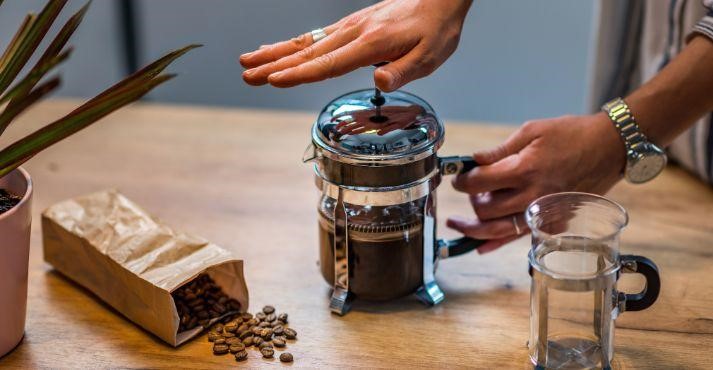
Using a French press is a straightforward method that produces rich and flavorful coffee. Follow these French press instructions to brew the perfect cup. Here’s a step-by-step guide to help you master the process.
Preparation
Before you start brewing, it’s essential to prepare your French press. Begin by preheating the carafe. Pour hot water into the carafe, let it sit for a minute, and then discard the water. This step ensures that your coffee stays hot longer.
Gather all necessary tools, including a coffee grinder, scale, timer, and favorite coffee beans. Having everything ready will make the process smoother and more enjoyable.
Grinding Coffee Beans
The French press coffee grind size is crucial for a perfect brew. It would help if you had a coarse grind, similar to breadcrumbs. Too fine a grind can result in over-extraction and a bitter taste, while too coarse a grind can weaken the coffee. Use a burr grinder for consistent results.
If you’re new to grinding coffee, many online tutorials and videos can show you the ideal grind size for French press coffee.
Measuring Coffee and Water
For the best flavor, use the correct French press coffee ratio. A standard ratio is 1:15, which means 1 gram of coffee for every 15 milliliters of water.
For example, if you use 30 grams of coffee, you’ll need 450 milliliters of water. Use a kitchen scale to measure the coffee accurately and a measuring cup or scale for the water. Precision is critical to achieving the perfect brew.
Brewing Process
- Add coffee grounds: Place the measured coffee grounds into the preheated French press.
- Pour hot water: Heat to 93-96 degrees Celsius (200-205 degrees Fahrenheit). Pour the hot water over the coffee grounds, ensuring all grounds are evenly saturated.
- Stir gently: Use a wooden or plastic spoon to stir the coffee and water mixture. This helps to ensure even extraction.
- Place the lid: With the plunger pulled up, put the lid on the French press. This helps retain heat and prevent accidental spills.
- Let it steep: Allow the coffee to steep for 4 minutes. Timing is crucial to avoid under or over-extraction.
- Press the plunger: Slowly and steadily press the plunger down. The mesh filter will separate the coffee grounds from the liquid, leaving you with a smooth brew.
Serving
Once the coffee is ready, serve it immediately to prevent over-extraction, which can make it bitter. Pour the French press coffee into your favorite mug and enjoy it as is, or add milk, cream, or flavored syrups according to your preference.
This method provides a delicious cup and allows you to experiment with different flavors and styles, making it a versatile addition to your coffee menu.
Following these steps, you’ll master using a French press and enjoy a consistently excellent cup of coffee. Happy brewing!
Benefits of Using a French Press
Many coffee enthusiasts love the French press brewing method due to its simplicity and the rich, flavorful coffee it produces. Here are some of the key benefits of using a French press.
Rich Flavor Extraction
One of the standout benefits of using a French press is the rich flavor extraction it offers. The French press coffee method uses a complete immersion process, meaning the coffee grounds are fully submerged in water during brewing.
This allows for a more thorough extraction of the coffee’s oils and flavors, resulting in a rich and robust taste. Unlike other methods using paper filters, the French press retains these oils, contributing to the coffee’s complex flavor profile.
This method is perfect for those who appreciate their coffee’s more profound, intense flavors.
Control Over the Brewing Process
Using a French press gives you complete control over the brewing process. You can adjust the French press coffee grind size, water temperature, and steeping time to suit your taste preferences.
For instance, you can experiment with different grind sizes to see how it affects the flavor and strength of your coffee.
Similarly, you can control the water temperature (ideally between 93 and 96 degrees Celsius) to ensure optimal extraction. The steeping time, typically around 4 minutes, can also be adjusted to make your coffee stronger or milder.
This level of customization is difficult to achieve with other brewing methods, making the French press a favorite for those who enjoy tailoring their coffee rituals.
Eco-Friendly and Cost-Effective
Another significant advantage of using a French press is its eco-friendliness and cost-effectiveness. Unlike many other coffee brewing methods, the French press does not require paper filters, reducing waste and saving money over time.
French press coffee makers are generally durable and long-lasting, especially those made from stainless steel or high-quality glass.
This durability means you won’t need to replace your coffee maker frequently, resulting in further cost savings. For those who enjoy a cold brew, the French press can also make a delicious cold brew coffee, adding to its versatility and value.
The French press offers rich flavor extraction, unparalleled control over the brewing process, and significant eco-friendly and cost-effective benefits.
Whether enjoying a hot cup of French press coffee in your favorite coffee mugs and cups or experimenting with a cold brew, the French press is a versatile and valuable tool in any coffee lover’s arsenal.
Tips for Perfecting Your French Press Coffee
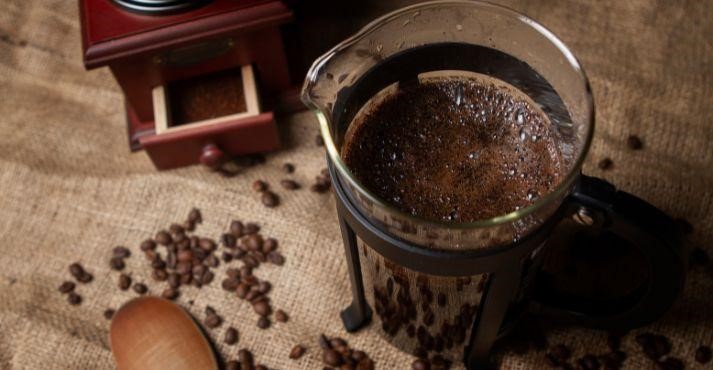
Brewing the perfect cup of French press coffee can be a delightful ritual that brings out the best in your coffee beans. Here are some tips to help you refine your technique and enjoy the most flavorful cup every time.
Adjusting Grind Size
The grind size of your coffee beans is crucial in determining the taste of your French press coffee. If your coffee tastes too bitter, it’s likely over-extracted, meaning the grind is too fine. Conversely, if your coffee is weak or sour, it’s under-extracted, indicating the grind needs to be coarser.
Start with a coarse grind, like breadcrumbs, to perfect your grind size. If the coffee tastes too strong or bitter, make the grind coarser. If it’s too weak, make the grind slightly finer.
Adjusting the grind size incrementally allows you to fine-tune the flavor to your liking. Using a burr grinder can help you achieve a consistent grind size, which is essential for a balanced brew.
The Perfect French Press Coffee Ratio
The French press coffee ratio plays a significant role in the final flavor of your brew. The standard French press coffee-to-water ratio is 1:15, which means using 1 gram of coffee for every 15 milliliters of water. This ratio ensures a balanced brew, highlighting the coffee’s rich flavors and natural oils.
- Standard Ratio (1:15): Use 450 milliliters of water for every 30 grams of coffee. This ratio provides a well-balanced cup, neither too strong nor too weak.
- Stronger Brew (1:12): For a more intense flavor, use 1 gram of coffee for every 12 milliliters of water. For example, 30 grams of coffee with 360 milliliters of water.
- Lighter Brew (1:18): If you prefer a milder coffee, use 1 gram for every 18 milliliters of water. For instance, 30 grams of coffee with 540 milliliters of water.
Experimenting with these ratios can help you find the perfect strength for your taste preferences. Adjusting the French press ratio is a simple way to customize your coffee experience.
Water Quality
The quality of water you use can significantly affect the taste of your French press coffee. Using clean, filtered water ensures that no unwanted flavors from tap water interfere with the coffee’s natural taste. Coffee is mostly water, so using high-quality water makes a noticeable difference.
Here are some tips for ensuring your water is optimal for brewing:
- Filtered Water: Always use filtered water to remove impurities that can alter the taste of your coffee.
- Temperature: The ideal water temperature for brewing French press coffee is between 93-96°C (200-205°F). Water that is too hot can cause over-extraction, making the coffee bitter, while water that is too cool can lead to under-extraction, resulting in a weak brew.
- Freshness: Use fresh water each time you brew. Stale water can affect the overall flavor of your coffee.
Additional Tips for Perfecting Your Brew
- Preheat the French Press: Preheat your French press by filling it with hot water before adding coffee grounds. This helps maintain the brewing temperature and improves the extraction process.
- Stirring: After pouring the hot water over the coffee grounds, stir the mixture gently to ensure all grounds are evenly saturated. This promotes even extraction.
- Steep Time: Allow the coffee to steep for about 4 minutes. Adjusting the steep time can help you control the strength of your coffee. A longer steep time can result in a more potent brew, while a shorter time can produce a milder coffee.
- Plunging: Press the plunger down slowly and steadily. This helps avoid disturbing the ground too much, making the coffee gritty.
By following these tips, you can master using a French press and enjoy a consistently excellent cup of coffee. Adjusting the grind size, perfecting the French press coffee ratio, and using high-quality water are critical steps in refining your coffee brewing skills.
Common Mistakes and How to Avoid Them
Brewing coffee with a French press is relatively straightforward, but common mistakes can affect the quality of your coffee. Here’s how to identify and avoid these pitfalls to ensure you always enjoy a perfect cup of French press coffee.
Over/Under Extraction
Over-extraction and under-extraction are two common issues that can ruin the taste of your coffee.
- Over-Extraction: Coffee that has been over-extracted will taste bitter and harsh. This occurs when the coffee grounds are exposed to water for too long or if the grind size is too fine. Try using a coarser grind to correct over-extraction and reduce the steeping time. The ideal steep time is around 4 minutes. If the coffee still tastes bitter, shorten the brewing time slightly.
- Under-Extraction: Under-extracted Coffee will taste sour and weak. This happens when the coffee grounds are not in contact with water long enough or if the grind size needs to be more coarse. To fix under-extraction, use a finer grind and ensure the steeping time is long enough.
Incorrect Grind Size
The grind size of your coffee beans is crucial for making good French press coffee. Here’s how different grind sizes can impact your brew:
- Too Fine: If the grind is too fine, the coffee can become over-extracted, resulting in a bitter taste. Acceptable grounds can also clog the filter, making it difficult to press the plunger and leading to sediment in your coffee.
- Too Coarse: If the grind is too coarse, the coffee can be under-extracted, leading to a sour and weak flavor. Coarse grounds release their flavors less effectively during the brewing process.
Aim for a coarse grind that resembles breadcrumbs to find the right French press coffee grind size. If you need more clarification, start with a coarse grind and adjust based on taste. Using a burr grinder can help you achieve a consistent grind size, which is essential for a good brew.
Improper Plunging Technique
The plunging technique is another essential aspect of making French press coffee. Improper plunging can result in sediment in your cup or damage your French press. Here’s how to do it correctly:
- Slow and Steady: After the coffee has steeped for about 4 minutes, place the lid on the French press with the plunger pulled up. Slowly and steadily press the plunger down. Applying too much force or plunging too quickly can disturb the ground, causing sediment to pass through the filter.
- Consistent Pressure: Use consistent pressure while plunging. If you encounter resistance, it’s likely because the grind size is too fine. Stop and adjust the grind size for the next brew.
- Avoid Tilting: Keep the plunger straight to ensure even pressure and to avoid pushing grounds past the filter.
Proper plunging helps to separate the coffee grounds from the liquid, resulting in a smooth cup of coffee.
French Press vs. Other Brewing Methods
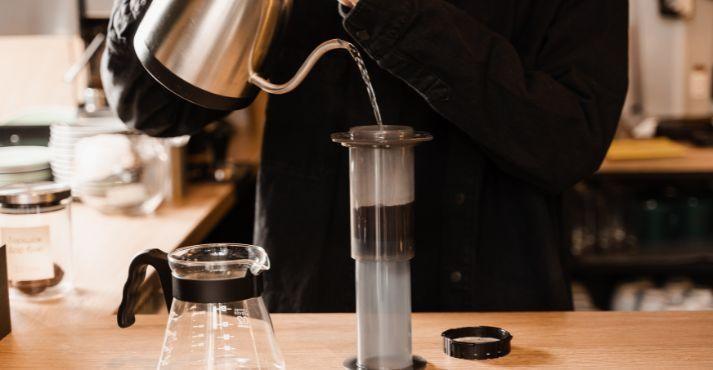
Exploring different coffee brewing methods can enhance your coffee experience by offering a variety of flavors and textures. Here’s a comparison of the French press with other popular brewing methods to help you understand their unique characteristics.
French Press vs. Drip Coffee
French Press Coffee and drip coffee differ significantly in taste, convenience, and cost. The French press method involves complete immersion, allowing coffee grounds to steep in hot water, which results in a rich, robust flavor. On the other hand, Drip coffee pours hot water over coffee grounds, which drips through a filter, often resulting in a cleaner but less intense flavor.
- Taste: French press coffee is fuller-bodied and more flavorful due to the retained oils and fine particles. Drip coffee is smoother and cleaner but can need more depth.
- Convenience: Drip coffee machines are generally more convenient for brewing multiple cups quickly and consistently.
- Cost: French press devices are usually cheaper and don’t require paper filters, making them more cost-effective over time.
French Press vs. Espresso Coffee
French press coffee and espresso are at opposite ends of the coffee spectrum regarding the brewing process and flavor.
- Brewing Process: The French press uses immersion brewing, while espresso uses pressure to force hot water through finely-ground coffee.
- Flavor Profiles: French press coffee is rich and full-bodied, with a smooth texture. Espresso is intense and concentrated, with a crema layer on top.
- Versatility: Espresso serves as a base for coffee drinks like lattes and cappuccinos. French press coffee is typically enjoyed independently or with simple additions like milk or sugar.
French Press vs. Pour Over Coffee
Pour-over and French press methods offer unique advantages, making them favorites among coffee enthusiasts.
- Taste: Pour over coffee is clean and bright, highlighting the intricate flavors of the coffee beans. French press coffee is fuller and more robust due to the immersion method.
- Brewing Process: Pour over requires a steady hand and precise pouring technique, often using a gooseneck kettle. The French press is more straightforward, requiring just immersion and plunging.
- Convenience: The French press is generally more straightforward and quicker to use, making it ideal for a hassle-free brewing process.
French Press vs. AeroPress Coffee
Both the French press and AeroPress are famous for their simplicity and the quality of coffee they produce.
- Taste: French press coffee is richer and more robust due to the total immersion method. Depending on the technique used, AeroPress coffee can vary from espresso-like to clean drip coffee.
- Brewing Process: The AeroPress uses air pressure to push water through coffee grounds, which can be quicker and result in a different texture. The French press relies on gravity and a mesh filter.
- Portability: The AeroPress is more portable and convenient for travel due to its compact size and lightweight design.
In summary, each brewing method offers distinct advantages. The French press stands out for its rich, full-bodied coffee and simple brewing process.
Frequently Asked Questions (FAQs)
How long should you let your French press sit?
Let your French press coffee steep for about 4 minutes. This steeping time allows optimal extraction, balancing flavor and strength without over-extracting the coffee.
Can you drink French press every day?
Yes, you can drink French press coffee every day. However, because it retains natural oils and fine particles, it can be stronger and richer than filtered coffee. Enjoy it in moderation if you’re sensitive to caffeine or have health concerns.
Can you make Espresso in a French press?
No, you cannot make authentic espresso in a French press. Espresso requires high pressure to brew, while a French press uses a simple immersion method. However, you can create a robust, espresso-like coffee using a finer grind and less water.
Conclusion
A French press can elevate your coffee experience, allowing you to enjoy rich and flavorful brews easily.
This method gives you control over every aspect of the brewing process, from grind size to steeping time, ensuring a perfect cup every time.
Whether you’re new to coffee or an experienced barista, mastering the French press instructions will add a versatile tool to your coffee-making arsenal.
With the right equipment, attention to detail, and a little practice, you can savor the deep, robust flavors only a French press can offer.

